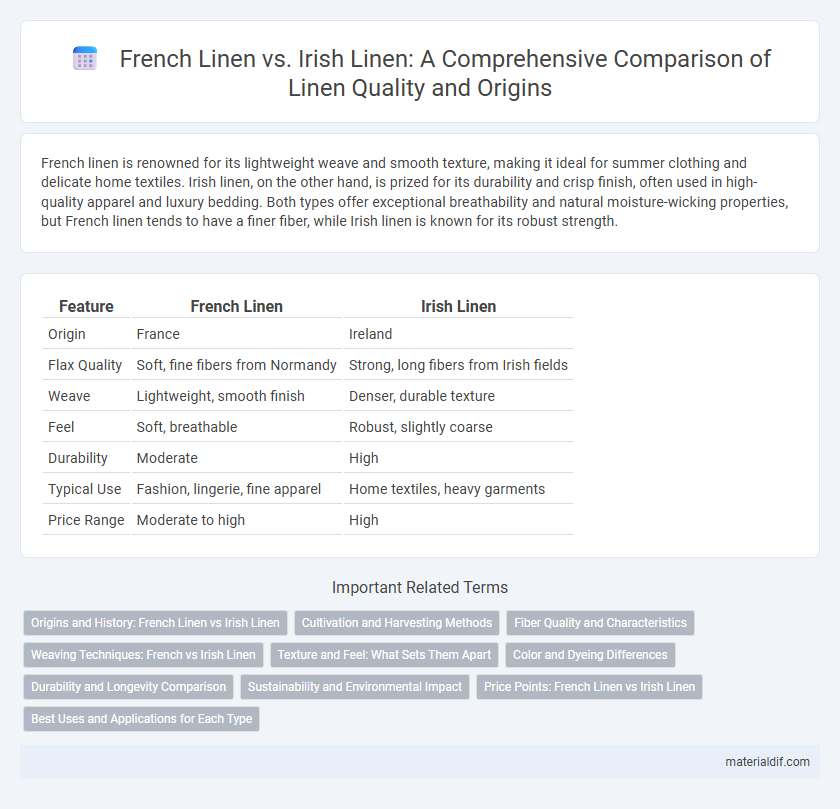French linen is renowned for its lightweight weave and smooth texture, making it ideal for summer clothing and delicate home textiles. Irish linen, on the other hand, is prized for its durability and crisp finish, often used in high-quality apparel and luxury bedding. Both types offer exceptional breathability and natural moisture-wicking properties, but French linen tends to have a finer fiber, while Irish linen is known for its robust strength.
Table of Comparison
| Feature | French Linen | Irish Linen |
|---|---|---|
| Origin | France | Ireland |
| Flax Quality | Soft, fine fibers from Normandy | Strong, long fibers from Irish fields |
| Weave | Lightweight, smooth finish | Denser, durable texture |
| Feel | Soft, breathable | Robust, slightly coarse |
| Durability | Moderate | High |
| Typical Use | Fashion, lingerie, fine apparel | Home textiles, heavy garments |
| Price Range | Moderate to high | High |
Origins and History: French Linen vs Irish Linen
French linen originates from the flax fields of Normandy, where cultivation dates back to the Middle Ages, known for its fine fiber and smooth texture ideal for delicate fabrics. Irish linen, rooted in the flax-growing regions of Ulster since the 17th century, boasts a rich heritage linked to skilled craftsmanship and durability, often associated with traditional heritage textiles. Both linens reflect unique regional climates and flax varieties, contributing to distinct textures and quality revered in luxury linen markets.
Cultivation and Harvesting Methods
French linen is primarily sourced from flax grown in the Normandy region, where a cool and damp climate extends the growing season, allowing fibers to develop longer and finer. Harvesting methods in France often involve dew-retting, where flax is laid out on fields to naturally break down the pectin binding fibers through exposure to morning dew and moisture. In contrast, Irish linen flax is cultivated in the rich, well-drained soils of Leinster, with harvesting emphasizing water-retting, submerging stalks in purified water to produce stronger and smoother fibers ideal for luxury textiles.
Fiber Quality and Characteristics
French linen is renowned for its smooth, fine fibers derived from flax grown in the Normandy region, offering a soft texture and excellent durability. Irish linen is sourced primarily from flax cultivated in Ireland, characterized by longer, coarser fibers that contribute to its strength and robustness. Both types feature distinct fiber qualities, with French linen favored for lightweight, refined textiles and Irish linen prized for heavy-duty, textured fabric applications.
Weaving Techniques: French vs Irish Linen
French linen is renowned for its fine, smooth texture achieved through a weaving technique that emphasizes tight, uniform weaves, often using traditional handloom methods. Irish linen utilizes a weaving process characterized by a slightly looser weave, which enhances fabric durability and breathability, typically crafted with a blend of mechanical and handloom techniques. Both weaving approaches highlight their regional heritage while providing distinct tactile qualities suited for various high-quality linen products.
Texture and Feel: What Sets Them Apart
French linen is renowned for its smooth, refined texture and crisp feel, thanks to the region's unique flax-growing conditions and advanced weaving techniques. Irish linen boasts a slightly coarser, more textured surface with a soft, natural hand that reflects its traditional spinning and weaving methods. The distinct tactile qualities of French linen offer elegance and sophistication, while Irish linen provides rustic charm and durability.
Color and Dyeing Differences
French linen typically features a naturally lighter, creamy beige hue due to the flax grown in Normandy's cooler climate, resulting in finer fibers that absorb dyes more evenly. Irish linen, usually produced from flax grown in the damp Irish climate, tends to exhibit a slightly whiter, brighter base color but can have coarser fibers that may cause dyes to appear less saturated. The dyeing process for French linen often yields richer, more consistent colors, whereas Irish linen may require additional treatments to achieve comparable dye depth and uniformity.
Durability and Longevity Comparison
French linen is renowned for its smooth texture and fine weave, yet Irish linen stands out with greater durability due to the traditional long flax fibers sourced from Ireland. Irish linen's fibers are meticulously spun to enhance strength, resulting in fabric that resists wear and tear more effectively over time. This superior longevity makes Irish linen the preferred choice for high-quality garments and home textiles intended for extended use.
Sustainability and Environmental Impact
French linen is renowned for its sustainable cultivation practices, often grown in the Normandy and Brittany regions where crop rotation and minimal pesticide use reduce environmental impact. Irish linen, sourced mainly from the flax fields of Northern Ireland, emphasizes eco-friendly processing techniques, including water-efficient retting and natural dyeing methods, which lower its carbon footprint. Both types of linen contribute to sustainable fashion by offering biodegradable, durable fibers that require less water and chemicals compared to conventional cotton.
Price Points: French Linen vs Irish Linen
French linen is generally more expensive than Irish linen due to the meticulous flax cultivation and aging processes in France, which enhance fiber strength and texture. Irish linen offers a slightly more affordable option while maintaining high quality, benefitting from Ireland's long history of flax weaving and skilled craftsmanship. Price differences reflect not only production techniques but also brand prestige and regional harvesting practices.
Best Uses and Applications for Each Type
French linen, known for its fine texture and long, smooth fibers, excels in high-end apparel and delicate household textiles like luxury bedding and lightweight garments. Irish linen offers a coarser, more durable weave ideal for table linens, upholstery, and traditional clothing that requires ruggedness and longevity. Both types perform well in their respective applications due to their distinct fiber qualities and weaving techniques.
French Linen vs Irish Linen Infographic

 materialdif.com
materialdif.com